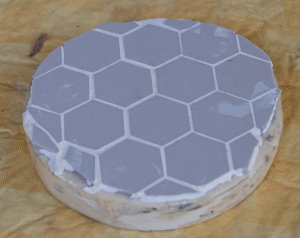The Grinding Tool
Making a 4.25 Inch Dobsonian
Reflector Telescope

Options
For my first 12.5 inch mirror, I used an
8 inch piece of glass for the tool. It
had already been used at least once, and was convex on both sides, although
only slightly so. This is the classic
method. This turned out to be bad for
a number of reasons. Regardless of
what type of tool you use, you really want one side of your tool to be very
flat. That's the side you won't be
grinding on. If it's not reasonably
flat, when you rub the mirror blank against it, it will rock and that is very
bad.
The
Price of Glass
In case you are not aware, the Corning
glass works recently closed down a foundry that was responsible for most of the
borosilicate (trademarked Pyrex by Corning) glass blanks made in the US. For a while this seemed to be causing a
scarcity, forcing the price of blanks and tools up. Recently I think I've been seeing a rebound, but I'm not at all
sure. In any case, this caused me to
investigate the other common option, a tool cast of plaster of Paris, covered
with tiles. There are other options
for the casting material. I've used
Fixall successfully, and I've heard that the material they make dental casts
from works well, cures in an hour and is waterproof although at a somewhat
higher price. Some disadvantages with
plaster of Paris are that it takes about a week to cure, and you probably want
to coat it with epoxy to waterproof it.
I found that this didn't seem to be necessary with the Fixall. While I've not seen it suggested anywhere,
I think that a wooden tool should work equally well, and I plan to try this out
on my next project.
The
Kit
I bought a grinding kit with blank and
grits from Firsthand
Discovery and
separately their tool making kit. I
had good luck with both kits, but the tool ingredients can be easily purchased
separately. The tiles can be found
on-line at Home
Depot if you are willing to buy in quantity. The best type of epoxy seems to be the type that comes in a
double cylinder plunger.
The
Advantage to Tiles
There is an extra step in making the
tool using tiles, however there turned out to be a few advantages other than
the cost. When you get to the fine
grinding, with a glass tool you will find a times a tendency for the tool and
the blank to freeze together. This is
somewhat un-nerving, although easy to fix if you are calm. You put the two in bucket of warm water
and they slowly separate. Because the
tile tool has small channels between the tiles, this doesn't happen.
The second advantage has to do with
tradition. Typically when done
grinding, you make a lap using the tool as your base. This makes it very difficult to go backward if you need to. But with a tile tool, just keep it. Make another slab for the base of your
lap. When finished with your mirror,
you can keep both tools for a future project.
I recommend that when you glue your tiles
on, you put them as close together as possible. I don't know what I was thinking, but I put in spacers. I guess I was thinking ahead to the way you
make a lap. This caused me to waste a
lot of grit, because the spaces would
fill in. Before my second go
around on the fine grinding, I filled in the cracks with plaster of Paris. Some of this got on the tool, but came off
as soon as I started grinding with 80 grit.
I tried to fill in the edges with
broken tiles. I'm pretty sure this was
a waste of time. I'd probably have
lost less than 10% of the area without them, and for a bigger tool it will be
even less.